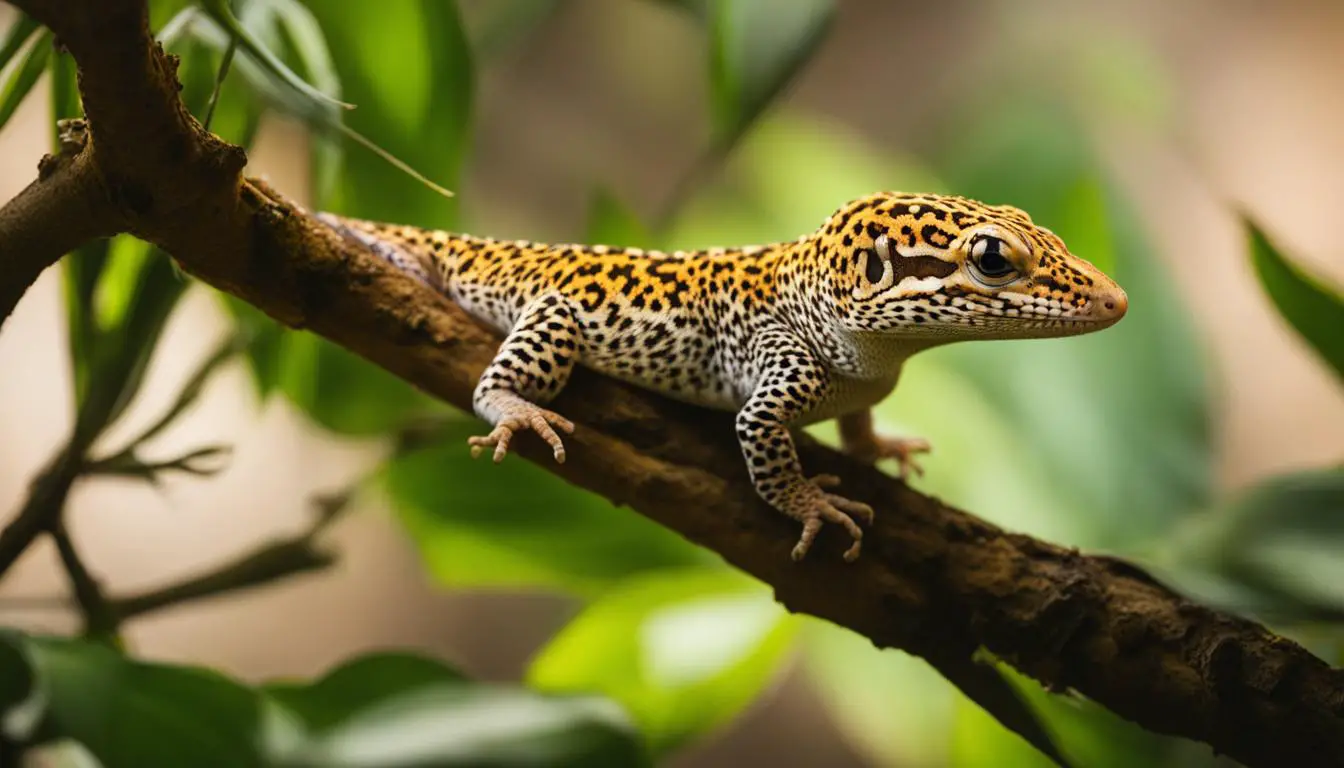Leopard gecko poop frequency is an important factor to consider when assessing the health of these fascinating reptiles. Understanding their bowel movements and excretion patterns can provide valuable insights into their digestion rate and overall well-being.
Healthy leopard gecko poop should have specific characteristics that indicate proper digestion. It should be sausage-shaped, long, and well-formed, with a dark brown bottom (the feces) and an off-white tip (urates) accompanied by an occasional liquid pee. The poop should have a mild smell that dissipates over time.
On the other hand, unhealthy leopard gecko poops can manifest in various colors and consistencies, each potentially revealing different underlying issues. For example, white poop can result from ingesting shed skin or substrate, while green poop can indicate dietary changes or substrate ingestion. Yellow poop may suggest mineral overdose or dehydration, and black poop could be caused by bile or specific food sources.
Monitoring the frequency of leopard gecko poops is crucial to ensure their digestive system is functioning optimally. For adult leopard geckos, a poop frequency of 3-4 times a week is considered healthy, while baby geckos should excrete waste several times a day. However, if a gecko hasn’t pooped in a few days or shows irregular toilet habits, it is advisable to seek veterinary advice to address potential issues.
Key Takeaways:
- Healthy leopard gecko poop should be sausage-shaped, dark brown at the bottom, with an off-white tip and occasional liquid pee.
- Unhealthy leopard gecko poops can present in various colors and consistencies, indicating possible health issues.
- Monitoring leopard gecko poop frequency helps identify potential problems and ensure their overall well-being.
- Adult leopard geckos should poop 3-4 times a week, while baby geckos should eliminate waste several times a day.
- If a leopard gecko shows abnormal toilet habits or hasn’t pooped in a few days, it is important to seek veterinary advice.
Healthy Leopard Gecko Poop Characteristics
When it comes to your leopard gecko’s health, paying attention to their poop is important. Healthy leopard gecko poop has certain characteristics that indicate good digestion and overall well-being. Here are the key features to look out for:
- Color: Healthy leopard gecko poop should be dark brown at the bottom, with an off-white tip (urates) and occasional liquid pee. This coloration is a sign of a healthy digestive system.
- Shape: The poop should be sausage-shaped, long, and well-formed. This indicates that the gecko’s body is efficiently processing food.
- Smell: Healthy leopard gecko poop has a mild smell that dissipates after some time. This indicates that there are no underlying digestive issues.
By regularly observing and analyzing your leopard gecko’s poop, you can ensure that they are in good health. Healthy poop is a positive indicator of their overall well-being, digestion, and diet. If you notice any changes in the characteristics of their poop, it may be a sign of an underlying health issue, and seeking veterinary advice is recommended.
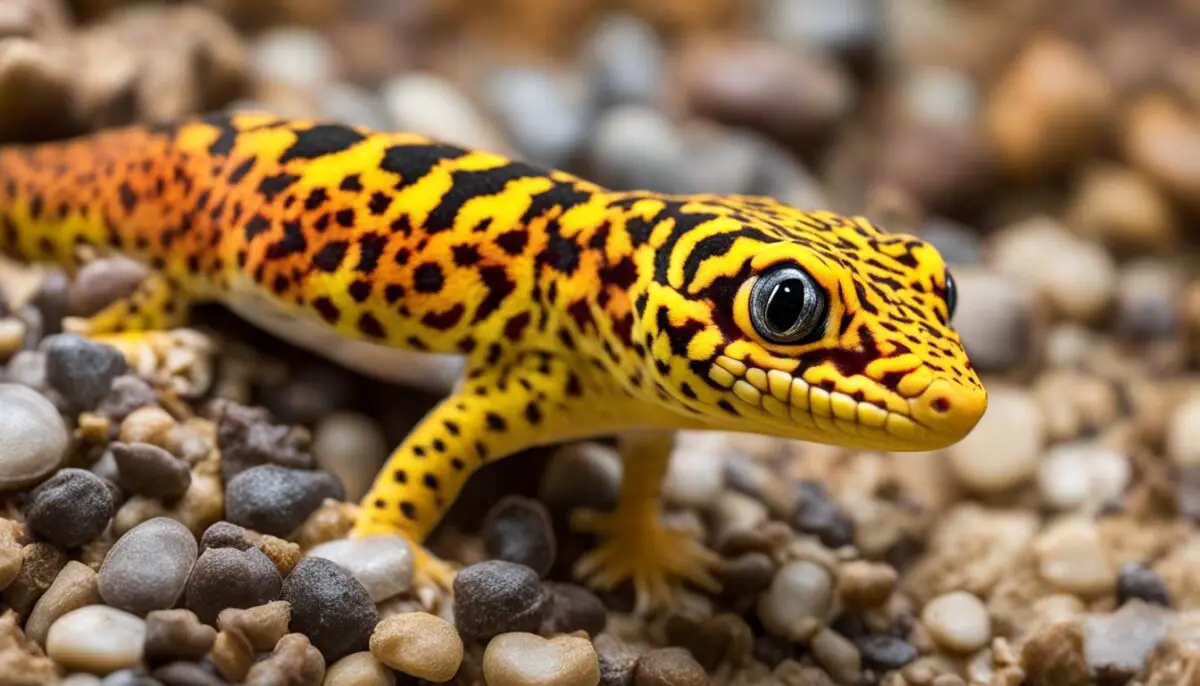
Unhealthy Leopard Gecko Poop Types and Causes
Unhealthy leopard gecko poop can come in various forms and indicate underlying health problems. It is important to understand the types and causes to take appropriate action and ensure the well-being of your gecko.
- Not pooping: This can be caused by impaction or dehydration. Impaction occurs when a gecko ingests unsuitable substances or substrate, leading to a blockage in their digestive system. Dehydration can result from insufficient water intake or low humidity levels. Both conditions require immediate attention to prevent further complications.
- White poop: This type of poop is often a result of ingesting shed skin or substrate. It could also indicate a lack of calcium. It is important to ensure that your gecko’s enclosure is clean and that they have a well-balanced diet to avoid this issue.
- Green poop: Green poop can be caused by ingesting green substrate or having a sudden change in diet. It is essential to monitor your gecko’s environment and food sources to prevent them from consuming anything that may cause digestive issues.
- Yellow poop: Yellow poop may indicate a mineral overdose or dehydration. It is crucial to provide your gecko with a balanced diet and access to fresh water to maintain their health.
- Gray poop: This type of poop is often a result of ingesting substrate. It is important to ensure that your gecko’s enclosure is free of loose materials that could be accidentally consumed.
- Watery poop: Watery or runny poop indicates diarrhea and may be a sign of bacterial infections or parasites. If you notice this type of poop, it is recommended to seek veterinary assistance for proper diagnosis and treatment.
- Presence of undigested insects in poop: If you see whole, undigested insects in your gecko’s poop, it could indicate impaction or a parasite infection. It is important to address these issues promptly to prevent further complications.
Unhealthy leopard gecko poop can be caused by various factors, including an unsuitable diet, ingestion of substrate, bacterial infections, and stress. It is crucial to identify the cause and take appropriate action to address the underlying issues.
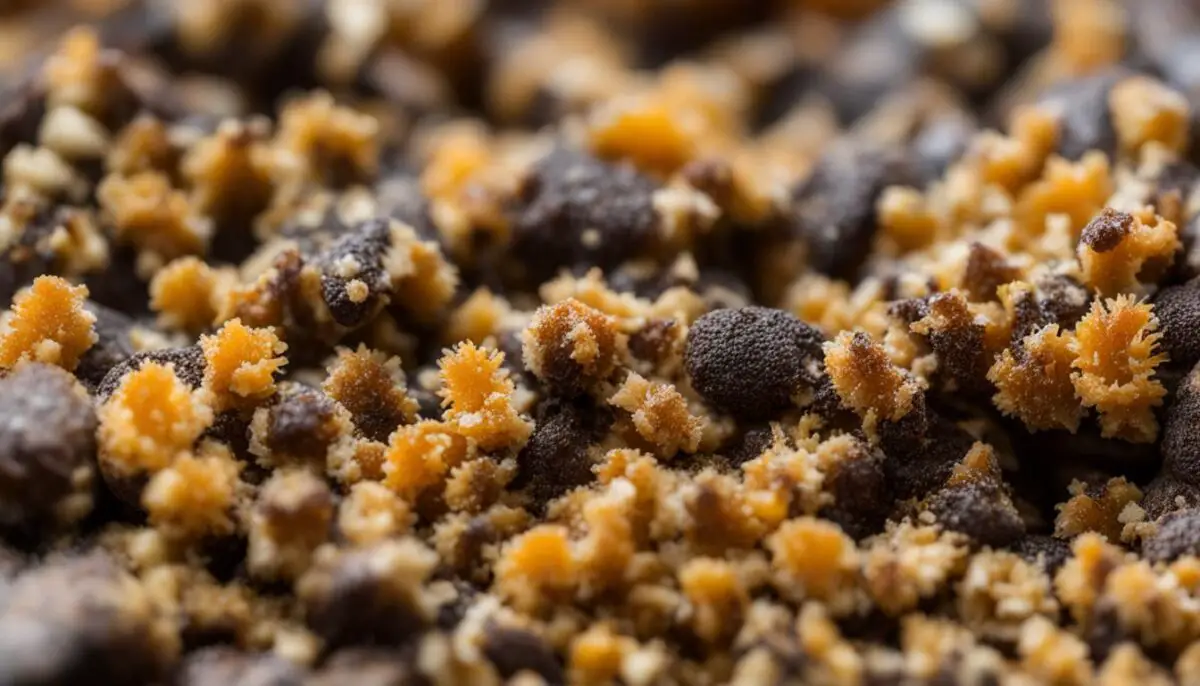
Frequency of Leopard Gecko Poop
The frequency of leopard gecko poop can vary depending on their age, diet, and general digestive capacity. Baby geckos tend to poop several times a day, which is considered normal. Adult geckos should poop at least 3-4 times a week or once a day. However, some adult geckos may only poop a few times a week but as long as they are healthy, active, and have a normal appetite, it is not a cause for concern.
If a gecko has not pooped in a few days or shows abnormal toilet habits, it may indicate dehydration, impaction, or inappropriate tank temperatures. Monitoring their poop frequency can help in identifying any potential health issues.
“Regular monitoring of leopard gecko poop frequency is crucial for ensuring their well-being and identifying any potential health problems.”
Here is a detailed breakdown of the frequency of leopard gecko poop:
- Baby geckos: Several times a day
- Adult geckos: 3-4 times a week or once a day
It’s important to note that every gecko is different, and their poop frequency can vary slightly. However, if a gecko consistently goes without pooping for more than a week or shows signs of distress, it is recommended to consult a veterinarian for a thorough examination.
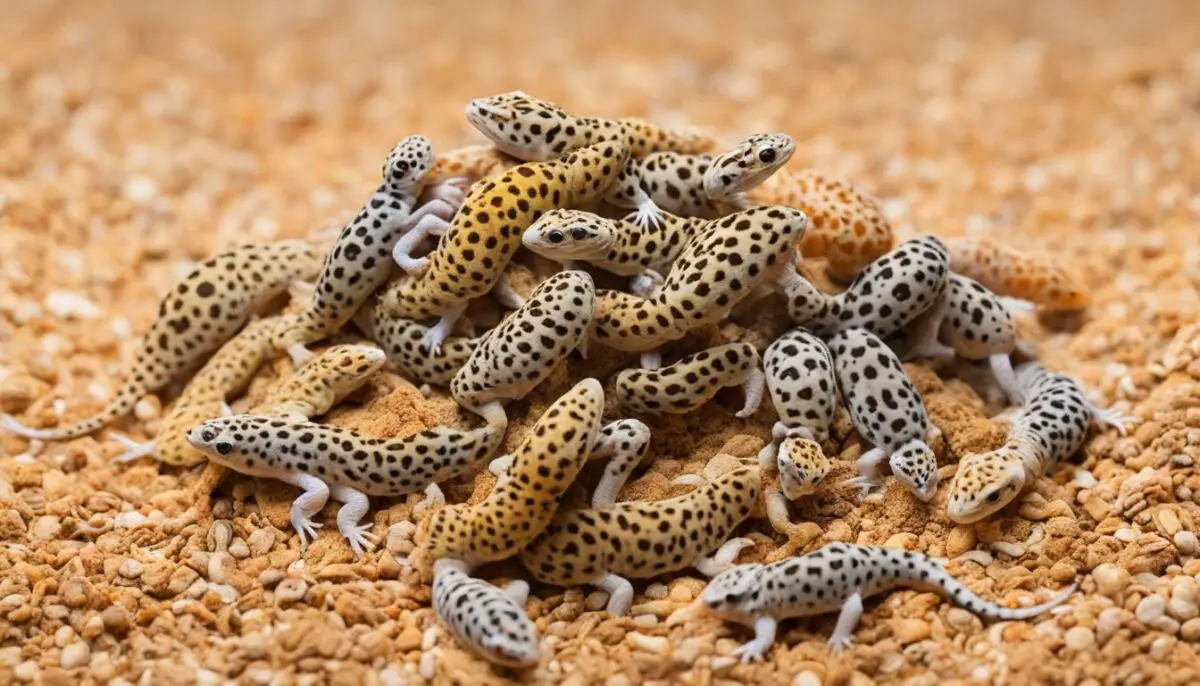
What to Do if Your Gecko is Not Pooping
If your leopard gecko is experiencing difficulty in pooping, it may be a concerning sign of impaction, dehydration, or unsuitable tank conditions. Impaction occurs when a gecko ingests inappropriate substances or substrate, resulting in a blockage in their digestive system. To address this issue, here are some steps you can take:
- Warm Water Compresses: Gently place a warm, damp cloth on your gecko’s belly to help stimulate their digestion and alleviate impaction. Make sure the water is lukewarm, not hot, to avoid any burns or discomfort.
- Temporary Food Withholding: Temporarily refrain from feeding your gecko until their bowel movements improve. This can help prevent further impaction and give their digestive system a chance to recover.
- Seek Veterinary Advice: If the problem persists or worsens, it is crucial to consult a veterinarian who specializes in reptiles. They can provide a thorough examination, offer appropriate treatment, and guide you on further steps to address the issue.
In addition to impaction, inadequate hydration can also contribute to constipation in leopard geckos. Ensure your gecko has access to fresh water at all times and maintain suitable humidity levels in their tank. Dehydration can further exacerbate digestive issues, so it is essential to address this aspect as well.
Checking the temperature and providing an appropriate heating setup in the gecko’s tank is crucial. Incorrect temperatures can hinder their digestion and overall well-being, leading to constipation. Ensure that the temperature gradient in the tank is conducive to their natural behavior and physiological needs.
Quote:
“Proper care and attention are vital when dealing with a leopard gecko that is not pooping. Prompt action, along with veterinary guidance, can help address impaction, dehydration, and other potential causes of constipation, ensuring the health and well-being of your gecko.”
If your leopard gecko continues to experience issues with not pooping despite your efforts, it is best to consult a veterinarian for further evaluation and treatment. Remember, proactive monitoring and seeking professional advice are crucial elements in ensuring your gecko’s digestive health.
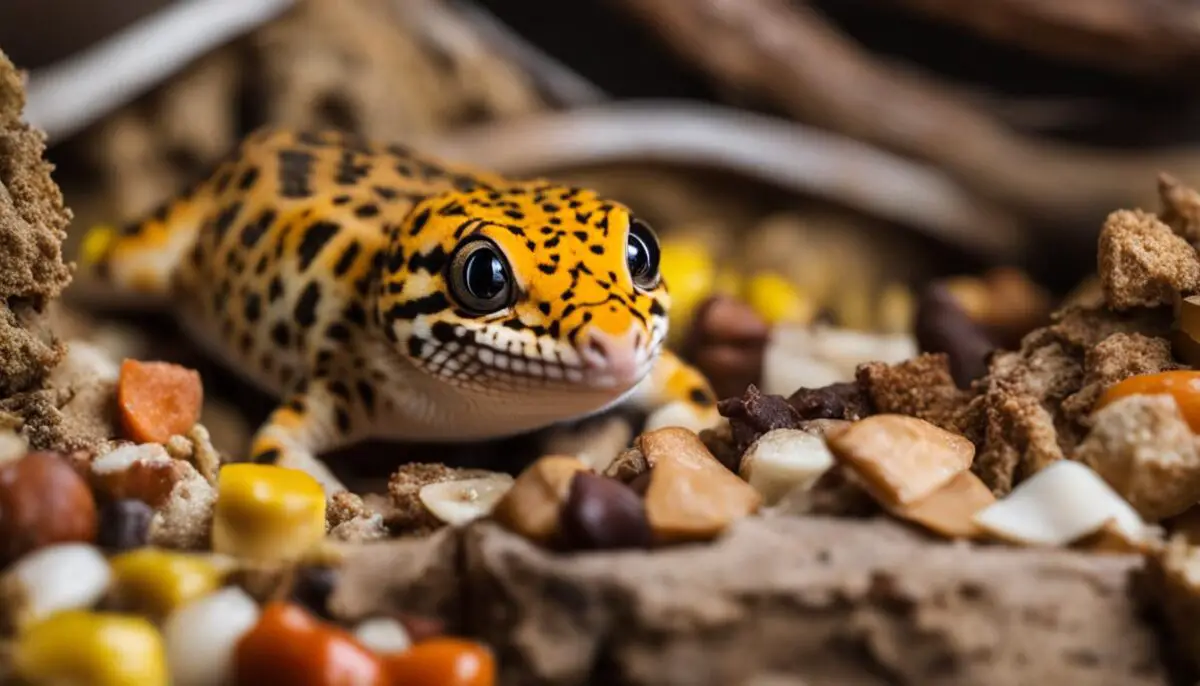
| Causes of Gecko Constipation | Common Symptoms | Treatment |
|---|---|---|
| Impaction due to ingesting unsuitable substrate or foreign objects | Loss of appetite, swollen abdomen, pain upon palpation | Warm water compresses, temporary food withholding, veterinary assistance |
| Inadequate hydration or dehydration | Dry skin, sunken eyes, lethargy | Provide fresh water, maintain appropriate humidity levels |
| Inappropriate tank temperatures | Decreased activity, reduced appetite, abnormal thermoregulation | Check temperature gradient, provide suitable heating setup |
Monitoring Gecko Poop and Overall Health
Monitoring gecko poop is crucial for assessing their overall health. Regularly observing and analyzing their poop can help identify any potential health problems or issues with their diet and environment.
Healthy gecko poop should be firm, well-formed, and have a mild smell that dissipates over time. By closely examining their poop, you can determine whether it aligns with the signs of healthy gecko poop, indicating good digestion and overall well-being.
If there are any changes in the color, consistency, or frequency of their poop, it is important to investigate and address the underlying causes. These changes can be indicative of digestive issues, dietary imbalances, stress, or other health concerns.
Collecting poop samples for examination by a veterinarian can provide valuable insights. This is especially important if you recently acquired a gecko or notice signs of illness. Analyzing the poop allows for proper diagnosis and treatment of any potential parasite infections or other health issues.
Monitoring gecko bathroom habits and conducting regular gecko poop analysis helps ensure their long-term health and well-being. By staying attentive to their bathroom patterns, you can detect any deviations early and take appropriate action.
“Regularly observing your gecko’s poop is like having a window into their overall health. It’s a simple yet effective way to ensure they’re thriving.”
To help you track and monitor your gecko’s poop, use the table below to record any changes or abnormalities:
| Date | Poop Color | Consistency | Frequency |
|---|---|---|---|
| MM/DD/YYYY | Brown | Well-formed | Normal |
| MM/DD/YYYY | Green | Watery | Increased |
| MM/DD/YYYY | White | Loose | Decreased |
By documenting these details, you can track any patterns or abnormalities in your gecko’s bathroom habits and seek appropriate veterinary care if necessary. Remember, informed monitoring is key to maintaining your gecko’s health and happiness.
Conclusion
In conclusion, monitoring the frequency of your leopard gecko’s poop is crucial for maintaining their overall health and well-being. Healthy leopard gecko poop should have specific characteristics, such as being sausage-shaped, dark brown at the bottom, with an off-white tip (urates), and occasional liquid pee.
However, unhealthy poop types and colors can indicate underlying issues such as digestive problems, impaction, dehydration, or even parasite infections. It is important to understand the normal poop frequency for different age groups and take appropriate action if your gecko is not pooping as expected.
Regularly monitoring your gecko’s poop and seeking veterinary advice when necessary can help ensure their health and longevity. By staying vigilant and taking proactive measures, you can provide the best care for your leopard gecko and ensure they live a happy and healthy life.
FAQ
How often do leopard geckos poop?
Leopard geckos should poop at least 3-4 times a week for adults and several times a day for babies.
What are the characteristics of healthy leopard gecko poop?
Healthy leopard gecko poop is dark brown at the bottom, with an off-white tip (urates) and occasional liquid pee. It should be sausage-shaped, long, and well-formed.
What are the types and causes of unhealthy leopard gecko poop?
Unhealthy leopard gecko poop can come in various colors and consistencies, such as white poop from ingesting shed skin or substrate, green poop from ingesting substrate or having a change in diet, yellow poop from mineral overdose or dehydration, and black poop from digestive bile or certain food sources. The causes can include an unsuitable diet, ingesting substrate, bacterial infections, and stress.
How often should leopard geckos poop?
Adult leopard geckos should poop at least 3-4 times a week or once a day. However, some adult geckos may poop a few times a week, as long as they are healthy, active, and have a normal appetite.
What should I do if my gecko is not pooping?
If your gecko is not pooping for a prolonged period, it could be a sign of impaction, dehydration, or inappropriate tank temperatures. Some steps you can take include warm water compresses on the gecko’s belly, temporarily withholding food, providing fresh water, ensuring proper humidity levels, and checking tank temperatures. If the problem persists, it is best to consult a veterinarian.
How should I monitor my gecko’s poop and overall health?
Regularly observing and analyzing your gecko’s poop can help identify any potential health problems or issues with their diet and environment. It is recommended to collect poop samples for examination by a veterinarian, especially if your gecko has recently been acquired or is showing signs of illness. This allows for proper diagnosis and treatment of any potential parasite infections or other health issues.

